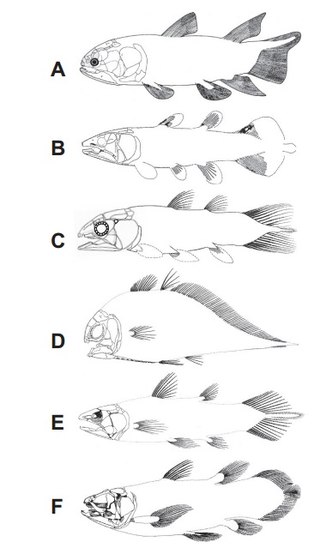
Rhabdoderma is an extinct genus of coelacanth fish in the class Sarcopterygii. It lived in the Carboniferous and Early Triassic (Induan), and its fossils have been found in Europe, Madagascar and North America. The type species was originally described as Coelacanthus elegans.
Eoctenodus is an extinct genus of prehistoric sarcopterygian or lobe-finned fish.
Devonosteus is an extinct genus of prehistoric sarcopterygian or lobe-finned fish.
Indocoelacanthus robustus is a fossil sarcopterygian. The holotype specimen was found in Lower Jurassic-aged riverine sediment of the Kota formation, in the Pranhita-Godavari valley at Boraigudem limestone ridge, about 30 kilometers southeast of Sironcha, India. The holotype is preserved in the museum of the Indian Statistical Institute.
Howidipterus is an extinct genus of prehistoric sarcopterygian or lobe-finned fish.

Heptanema is an extinct genus of prehistoric coelacanth from the Middle Triassic (Ladinian) of northern Italy and southern Switzerland.
Hainbergia is an extinct genus of prehistoric sarcopterygian or lobe-finned fish.
Hamodus is an extinct genus of prehistoric sarcopterygian or lobe-finned fish.
Osteoplax is an extinct genus of prehistoric sarcopterygians or lobe-finned fish.
Nesides is an extinct genus of prehistoric sarcopterygians or lobe-finned fish.
Muranjilepis is an extinct genus of prehistoric sarcopterygians or lobe-finned fish.
Moenkopia is an extinct genus of prehistoric sarcopterygians from the Coelacanthidae found in the Middle Triassic Moenkopi Formation of Arizona. The type, and only species, M. wellesi, was named in 1961 in honour of Samuel Paul Welles. It is only known from the holotype, UMCP 36193, a partial skull consisting only of the basisphenoid that was collected in 1939 or 1940 by Samuel Welles and briefly noted on by him in 1947, and other assorted specimens found before 2005 in the Radar Mesa by S. J. Nesbitt, W. G. Parker and R. B. Irmis.
Pseudosauripterus is an extinct genus of prehistoric sarcopterygians or lobe-finned fish.

Porolepis is an extinct genus of porolepiform sarcopterygian fish, from the Early Devonian Dniester Series of Ukraine, which is rich in Porolepis remains, and also the Nellen Koepfchen Beds of Germany. It lived alongside the dubious lophotrochozoan Macrodontophion. It was first described in 1858 but Porolepis was not named as a sufficient species until 1891.
Phaneropleuron is an extinct genus of prehistoric sarcopterygians or lobe-finned fish.
Youngichthys is an extinct genus of prehistoric sarcopterygians or lobe-finned fish from the upper Permian (Changhsingian) comprising a single species, Youngichthys xinghuansis. The single specimen of the fish was discovered in Zhejiang Province, China in 1981.
Tranodis is an extinct genus of prehistoric sarcopterygians or lobe-finned fish. It was a lungfish from the Upper Mississippian of North America.
Sunwapta is an extinct genus of prehistoric sarcopterygians or lobe-finned fish.
Scleracanthus is an extinct genus of prehistoric coelacanth lobe-finned fish. It lived during the Early Triassic epoch in what is now Spitsbergen, Svalbard.







